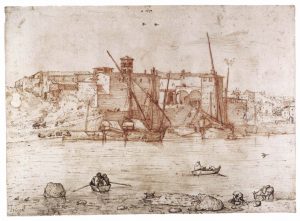 Exploring Rome through Drawing in the 16th Century (Rome, 6-8 Mar 24)
Exploring Rome through Drawing in the 16th Century (Rome, 6-8 Mar 24)
Rome, Bibliotheca Hertziana, Max Planck Institute for Art History, Mar 6–08, 2024
Deadline: Nov 12, 2023
Gernsheim Study Days.
In 1532, the painter Maarten van Heemskerck (1498–1574) set out on a journey from Haarlem to Rome. A collection of 94 sheets with about 160 drawings in the Berlin Kupferstichkabinett, including 66 sheets of a former sketchbook with drawings on both sides, provides a visual testimony to his five-year stay. It is the world’s largest corpus of Van Heemskerck’s Roman drawings, and also one of the most extensive by an artist traveling to Rome in the 16th century.
It is primarily thanks to his topographical views and vedute that the Rome of the 1530s became visually tangible in a comprehensive way for the first time. With single views of mostly ancient monuments, square vistas, and broad panoramas, his drawings have shaped our perception of the city, even though they often show reality in a filtered way. They focus on ruins, vegetation, or undeveloped areas. Other areas, such as the densely populated city center, on the other hand, are left out. Due to their extraordinary qualities, which oscillate between factual documentation and imaginative adaptation, Van Heemskerck’s Roman studies are omnipresent in research on the reception of antiquity and on the architecture and topography of the city of Rome in the Renaissance.
The Berlin collection of drawings will be presented in its entirety for the first time in an exhibition of the Kupferstichkabinett in cooperation with the Bibliotheca Hertziana – Max Planck Institute for Art History from April 26 to August 4, 2024.
The 2024 Gernsheim Study Days take the exhibition as an opportunity to inquire into the practices of topographical drawing in Cinquecento Rome, both during and after Van Heemskerck’s time. Rome was no longer just a pilgrimage destination: it was also a center of attraction and creativity for artists from near and far. At the same time, the city and its buildings themselves became the subject of artistic exploration, especially in the medium of drawing. What was observed was documented and specified in words and pictures: ancient buildings were surveyed and drawn, and the topography described and depicted in guidebooks, treatises, and maps. Printed series attest to the growing interest of a broader clientele.
The conference aims to methodically analyze the draughtsmen’s view of Rome and to better understand the mediality and function of their works. This can be done on the basis of case studies of individual persons; monuments or types of representation; as well as by means of comparative observations and syn- or diachronic analysis of concrete phenomena. The temporal framework is the 16th century; the topographical framework is the city of Rome and its surroundings.
The following questions may serve as suggestions:
– What is the relevance of drawn topomimetic city views and vedute in the artistic process? Are they creations of productive reception and transformation and thus starting points for something new?
– Which types of topographical views (from single views to the veduta to panoramas and bird’s-eye views) appear in which contexts?
– What selection preferences and appropriation practices in relation to perspectives, image detail, and exemplary monuments can be observed? What principles of spatial capture, movement patterns, and drawing routines occur?
– Which characteristics of the studied motifs are perpetuated in drawing? Which are emphasized, neglected, and ignored? What sorts of rededication and reinterpretation processes take place?
– What functions can topographic city views fulfill, for example as media of artistic training, as visual components of knowledge compilations (series of views, city guides, map collections), or as commissioned or collector’s works?
– Can formal differences be found between documentary views by artists of different origins (« North » and « South »), or correlations between their origin and their choice of modes of representation?
Application:
Please upload the following as PDF documents by November 12, 2023 on our recruitment platform:
https://recruitment.biblhertz.it/auth/Apply/0/Position/13565966/Step/0
– title and a 300-word abstract of the proposed paper
– brief CV (maximum 2 pages)
Conference languages are English, German and Italian.
The Bibliotheca Hertziana will organize and pay for accommodation and reimburse travel costs (economy class) in accordance with the provisions of the German Travel Expenses Act (Bundesreisekostengesetz).
Concept and organization: Tatjana Bartsch, Tanja Michalsky, Johannes Röll
Invited keynote speaker: Ilja M. Veldman
SOurce : https://arthist.net/archive/40269

Leave a Reply
You must be logged in to post a comment.